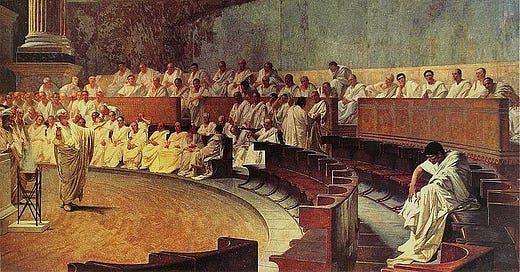Let Aristotle Help You Improve Your Arguments and Writing Skills
The ancient art of rhetoric that is more useful than ever today.
Two of the most important aspects of impactful writing are storytelling and persuasion.
We will talk about the art of storytelling some other day. Today, let’s take help from history to understand this critical art of rhetoric.
More than 2000 years ago, this man called Aristotle bifurcated the art of rhetorical writing into three broad segments.
Honestly speaking, these used to confuse me a lot. Like “what the hell do I do with it? Why is it even important?”
But trust me, once you get the hang of it and try to process your speech or writing through this filter, you will see that you are able to present things more clearly.
Before we get into what these three popular forms of rhetoric are, let’s establish some grounds on why we need them in the first place.
Why Rhetoric?
Even history is polarised when you ask if rhetoric is good or bad.
On one hand, where Aristotle wrote a whole book on rhetoric, there was also Plato, who was totally against it.
He refuted this idea by saying it was too easy a victory and “the rhetorical standpoint is powerful despite being anti-philosophical”.
Okay, so everyone believes it’s powerful.
Now onto ethics. If we look at not-so-distant history, we can see people from Martin Luther King Jr. to corrupt politicians using the power of rhetoric.
Some use it to change society for the better, while others use it for fulfilling their own selfish motives. It depends.
How the art of persuasion is used depends highly on the hands it falls into. And according to Aristotle, rhetoric is nothing but the ability to identify the available means of persuasion.
Since then, it has branched out a lot. Now there are more ways of using rhetorical entities than ever before.
But for now, we will limit it to Aristotle’s idea of rhetoric. We should first clear the basics, right?
What is Rhetoric?
In the words of Aristotle himself, the rhetoric is:
“The availability, in a particular case, to identify the available means to persuasion.”
So, we can say, Rhetoric = means of persuasion.
What are the means of persuasion we have?
There are three, and per Aristotle, each should be used in a different case. See: “in a particular case” in the definition above. Sometimes a combination of two or more can get your job done.
ETHOS (Persuasion by character or credibility)
PATHOS (Persuasion by emotions)
LOGOS (Persuasion by logic or argument)
Let's discuss each one of them in brief.
1. ETHOS: leverage character and/or credibility
We are easily persuaded by someone who comes up as trustworthy.
Being honest and straightforward is a superpower. People will trust you.
Your speech will appeal to them and your writing….
But first, you have to become a trustworthy individual. Aristotle describes three qualities of an individual who comes up as trustworthy:
good sense
good moral character
good will
If you have these three, you are all set to use the power of ethos where it's due.
2. PATHOS: leverage emotion
A master of persuasion should know different types of emotions and how to manage them—in themselves and in others.
According to Aristotle, there are 7 emotional dualities. One needs to access them thoroughly and see if the person they are talking to is feeling the same as they want them to feel with their words.
Calm vs Anger
Friendship vs Hatred
Fear vs Confidence
Shame vs Shameless
Kind vs Unkind
Pity vs Indignation
Envy vs Emulation
We don’t need to remember all this in order to sound persuasive. Just know that there’s a thing like that. Eventually, we’ll get the hang of it.
The main focus should be just being aware of “how the person I am speaking to feels?” And if that’s what I want him/her to feel.
Humans are emotional beings. that’s why this form single-handedly dominates all other forms of persuasion. Don’t be evil with it.
P.S. A master persuader will know how to excite these emotions when they are justified and calm them down when they’re not.
3. LOGOS: Persuasion by logic or argument or facts and figures
This one is the most ubiquitous form of persuasion. Almost every time we try to convince someone, we try to leverage facts and figures, logic and argument.
But the human brain is not wired that way. We are more susceptible to stories than numbers.
That’s why this form of persuasion often makes for a killing combo when used with either one of the above. Alone, it’s not that powerful.
One more thing worth noting is that the logic you give should be easy to follow else it might not be able to hold readers’ attention.
In conclusion, rhetoric is important as it helps truth prevail. Many people throughout history have used its power to bring about reforms as a result.
In today’s world, it’s highly used by brands in their advertising and it might have gone unnoticed thousands of times. But deep down they affect your decision-making when you’re standing in a supermarket.
Can you guess which form of persuasion has been used here?
Should the next issue be on this same topic? How have leaders in the past used it and how do brands use this concept to the fullest? Let me know.
I hope you found this issue informative as well as interesting. Until next time!









Love the ethos logos pathos combo